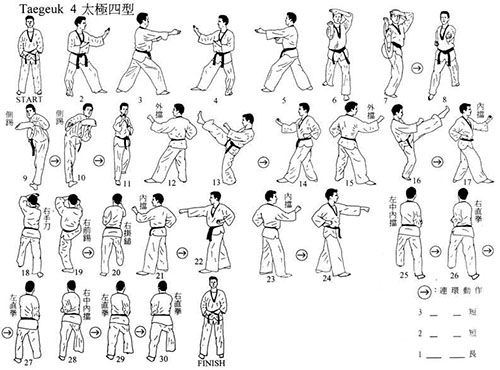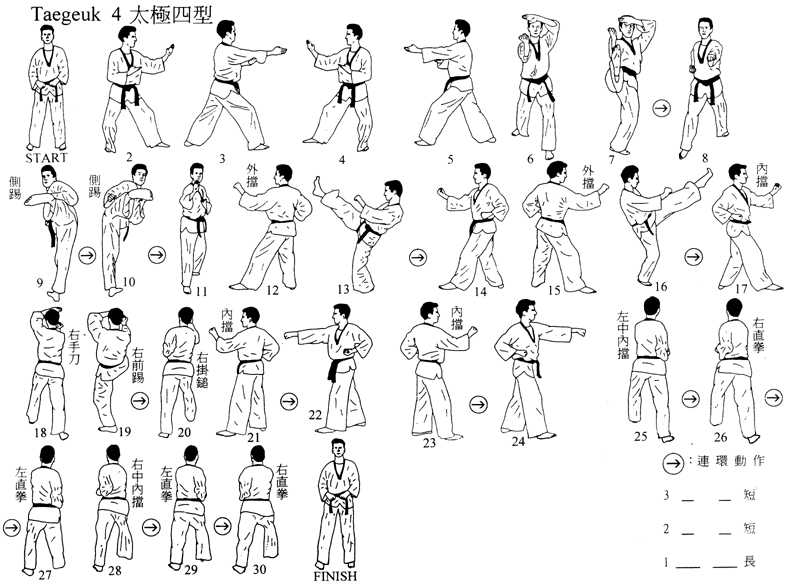Green Belt Form – Taegeuk Sa Jang
The Tae Kwon Do Form 4 or also known as Taegeuk Sa Jang applies the principle of Jin of Palgwe where Jin is male. It represents thunder, which with lightning, evokes fear and trembling, but reminds us that danger, like a thunderstorm, passes as suddenly as it comes, leaving blue skies, sunshine, and rain-freshened air in its wake.
The practice of this poomsae should help one act calmly and bravely in the face of loud and terrifying dangers, real or imagined, knowing that they, too, shall pass. In Taegeuk Sa Jang, one is responding calmly to threats of danger.
This form has you start to learn the Outside Middle Block, a palm out, many knife-hand technique, as well as a student’s first kicking combinations – two Side Kicks, first right, then left. This kicking combination needs the student to practice balance and coordination without sacrificing power.
This form also trains the coordination of the entire body with the arms and legs, particularly in steps 10 &12. Here, the student must execute a Front Kick and step back with the kicking leg into a Back Stance.
Then, when this combination is mastered, the student will be able to slide back smoothly and quickly as one motion. This combination is followed by a Reverse Inside Middle Block, in which the body is twisted 45 degrees towards the imaginary opponent.
Terms Used With This Form:
- Joon Bi Seogi – Ready Stance (i.e. “at ease”)
- KiHap – Shout
- Poomsae – Form
- Momtong Jireugi – Middle Punch
- Sonnal Mok Chigi – Knife Hand Strike to the neck
- Montong Maki – Middle Block
- Ap Chagi – Front Kick
- Yop Chagi – Side Kick
Video of Green Belt Form – Taegeuk Sa Jang
A visual of the form (poomsae) that, combined with the written part helped me learn the form more easily.
Green Belt Form – Taegeuk Sa Jang – Step by Step
Step 1:
From Joon Bi Seogi, turn to your left, with your left foot sliding to face your left while also delivering a Hansonnal Montong Maki with your left arm.
Step 2:
Step forward once with your right leg and deliver a Double Knife Hand with your right arm; this is executed the same way you would a middle punch, but with your palms open and facing to the side instead of being enclosed in a fist.
Step 3:
Turn 180 degrees to your right and execute Hansonnal Montong Maki with your right arm.
Step 4:
Step forward once with your left leg and deliver a Double Knife Hand with your left arm.
Step 5:
Turn 90 degrees to your left while executing a Jebipoom Sonal Mok Chigi with your right hand; this is executed by swinging your right hand to your opponent with your palm open and facing the sky while your other hand (also with an open palm) will go up to your forehead.
Step 6:
Deliver a front kick with your right foot and then execute a left middle punch.
Step 7:
Deliver a side kick with your left leg; this is executed by turning your body to face the side and lifting your folded leg and releasing the kick as it aligns with your head level. Land your leg in front of the other.
Step 8:
Deliver a side kick with your right leg and execute Hansonnal Montong Maki with your right arm.
Step 9:
Turn 180 degrees to your left on your right foot while executing a left middle block.
Step 10:
Perform a front kick with your right leg and land it behind your left leg and execute a right middle punch.
Step 11:
Turn 180 degrees to your right on your left foot while executing a right middle block.
Step 12:
Perform a front kick with your left leg and land it behind your right leg and execute a left middle punch.
Step 13:
Turn 90 degrees to your left on your right foot and deliver a Jebipoom Sonal Mok Chigi with your right arm outstretched.
Step 14:
Perform a front kick with your right leg and land it in front of your left leg and execute a right middle punch.
Step 15:
Turn 90 degrees to your left on your right foot and execute a left middle block.
Step 16:
Transition your left middle block to a right middle punch.
Step 17:
Turn 180 degrees to your right on your left foot and execute a right middle block.
Step 18:
Transition your right middle block to a left middle punch.
Step 19:
Turn 90 degrees to the left on your right foot and step your left foot forward, after this execute a right middle block and follow it up with two alternating middle punches starting with your left fist. Turn 180 degrees to your left on your right foot and return to Joon Bi Seogi.
Remember the Following:
- Form should begin and end at exactly the same spot. This indicates the quality of the performer’s stances and technique.
- Correct posture and body position must be maintained at all times.
- Muscles of the body should be either tensed or relaxed at the proper, critical moments in the form.
- The exercise should be performed in a rhythmic movement with an absence of stiffness.
- Movement should be accelerated or decelerated according to the specifications of that pattern.
- Exhale on exertion of each technique in order to maximize power.
- Each pattern should be perfected before moving to the next.
- Students should know the purpose of each movement.
Tips
Always keep your posture straight and strong to maintain balance and stability in your movements! In performing all forms, you should think not of executing techniques in a vacuum, but rather of responding to attacks from a number of opponents surrounding you.
In this form as well with all forms, you should always turn your head first, look at your imaginary opponent, then perform the required block or attack.
Always wait for the “Baro!” or end signal of your master before getting into Joon Bi Seogi after every form; this shows that you are taught to be disciplined during Tae Kwon Do sessions.


